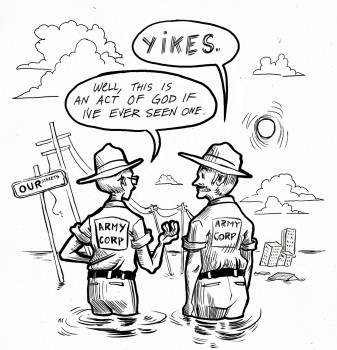by Antoine Schlumberger
 Three years later, we continue to hear that the effects of BP’s gusher aren’t a problem. The Coast Guard has stopped looking for oil from BP’s bottomless blowout, despite the tar balls that continue to wash ashore in Pensacola and Alabama, despite the fresh mats of mud-mixed oil that have shown up in Louisiana’s labyrinthine marshes along Barataria Bay. Fresh sheen is spotted above the rusting rig, but it’s not a problem. The billion-dollar machinery that was shattered in its attempt to harvest the pressurized oil of the deep lies littering the Macondo valley, but BP is allowed to leave their expensive trash there, lest cleaning their mess affect their profit margin.
Three years later, we continue to hear that the effects of BP’s gusher aren’t a problem. The Coast Guard has stopped looking for oil from BP’s bottomless blowout, despite the tar balls that continue to wash ashore in Pensacola and Alabama, despite the fresh mats of mud-mixed oil that have shown up in Louisiana’s labyrinthine marshes along Barataria Bay. Fresh sheen is spotted above the rusting rig, but it’s not a problem. The billion-dollar machinery that was shattered in its attempt to harvest the pressurized oil of the deep lies littering the Macondo valley, but BP is allowed to leave their expensive trash there, lest cleaning their mess affect their profit margin.
Three years later, the endless oil impacts are boring and ignored, and the rhetoric of RESTORATION is nigh.
The U.S. Congress has passed the RESTORE Act, which dedicates 80% of the penalties BP will pay for polluting US waters to restoration projects –restoration of the natural resources of the Gulf, but also restoration of the economies of the Gulf states. Despite the cries of advocates, the recommendations of presidentially appointed experts and the endless proof of a general failure to govern industry, this act was passed free of any funding for a citizen-led accountability group, or RCAC, as was won for Prince William Sound after the Valdez disaster. The States and Federal Agencies have held BP to a “landmark, unprecedented” 1 billion “early restoration” agreement for which BP has ponied up only $50 million so far.
At this rate, early restoration will take 20 years.
How can human beings conceive of “restoring” a Gulf ecosystem whose smallest animals were destroyed and mutated?
Three years later, the Justice Department has settled for 11 counts of manslaughter and a $4.5 billion payment for BP’s criminal charges, and three low-level scapegoats that face ongoing trials. BP’s stock shot up after the criminal settlement.
Three years later, the first large wave of independent scientific studies have rolled in, and they have documented that top-to-bottom, every link in the food chain has been hit. Besides the turtles and dolphins, besides the enigmatic pelicans or the charismatic plovers that we can watch from land, deep sea corals, floating plankton, menhaden, red snapper and lemon sharks, whale sharks, sperm whales, Orca, Bryde’s and Sei whales have all been injured. Do these injuries matter in the shrouded negotiations of the Justice Department as they move to settle civil charges?
To see how the restoration of the Gulf might proceed, we can look to the ongoing failures of the restoration of Louisiana, whose marshes the industry has destroyed over a few decades, and where much of the effort to restore North America’s interior sea will be focused.
What Restoration Looks Like
Let’s look at the MRGO restoration. The Mississippi-Gulf Outlet Canal (MRGO) was dug in 1927 as a shipping shortcut between the Gulf of Mexico and the Industrial Canal that separates the Upper & Lower Ninth Wards of New Orleans. It brought in salt water that killed off the South Louisiana cypress forests, and when the cypress died, their roots no could no longer hold the soil in place. The area around MRGO simply washed away. Six hundred thousand acres of coastal ecosystem were damaged by the MRGO, and over 27,000 acres of Louisiana marsh were destroyed.
Despite the massive scale and cost of the project– more earth was dredged in the digging of the MRGO than in the digging of the Panama Canal– the MRGO never got much use, and was hugely expensive to maintain. It was so expensive that the Army Corps of Engineers didn’t bother. In 2009, U.S. District Court for Eastern Louisiana ruled that the post-Katrina flooding of St. Bernard Parish and the New Orleans’ Lower Ninth Ward were directly caused by the Army Corps of Engineers’ criminal negligence in maintaining MRGO.
MRGO was finally closed to shipping in 2010, not as a result of the destruction it caused, but because completion of the Inner Harbor Navigational Canal lock meant that shipping & industrial companies no longer had use for the massive canal. Now the Army Corps of Engineers’ “restoration” of the areas affected by MRGO will begin.
The Corps will spend a lot of money to place rocks which have never naturally existed in Southern Louisiana around marshes it seeks to protect from further erosion. The Violet Canal is proposed to be connected to the Mississippi River via gates. For the “marsh creation via mechanical dredging” in the plan, the Corps will dredge the bottom of Lake Borgne… the same Lake Borgne where the storm waves that the MRGO channeled up into New Orleans were bor(g)n(e). Deepening Lake Borgne will aggravate any future storm surges.
At one of the public hearings on this plan, a local trapper bemoaned the Corps’ ignorance of marshes. From his time following the tracks of muskrat and nutria, he knew that to support plant and animal life, marshes must be able to drain. There was no consideration of this complicated need for drainage in the Corps’ plan to create new marsh. The man testified against the entire project: taking into consideration the rock armoring of shoreline and the deepening of Lake Borgne and the Violet Canal, the trapper proclaimed the whole plan to be another shipping channel, disguised as a marsh restoration project.
That trapper should have an Environmental Studies degree. Although the Corps individually may not have intended it, collectively, the biologists and engineers employed by the Corps and its numerous obscure “subcontractors” have approached the entire project of restoration with a material and logistical understanding derived from decades of experience building nothing but flood protection and shipping channels (such as MRGO) in the New Orleans district–the exact same projects that have done so much to cripple the ecological engine of our coast.
Similarly, we can count on the state’s engineers, especially those employed by the behemoth Shaw corporation (and whatever shadowy acronym has purchased Shaw in the wake of the Department of Justice’s $4.5 billion BP settlement) to design and to create restoration projects that look like roads or fill for commercial development, rather than attempting to mimic natural services, functions, and process.
Read the ecological reviews of other restoration projects. Although the purpose of these projects is supposedly to “create marsh,” the percentage of plant cover usually “fails stated targets” …the massive, sterile sand boxes created by the earth movers remain unplanted. The actual replanting of “marsh restoration” projects is always the first item to be cut.
Wetlands science is very clear that wetlands are defined by a triad of water, plants, and soil. Most restoration projects assume plants will just somehow appear. Water flow is an afterthought, and soil is hardly ever mentioned. The actual organic soils that do the biogeochemical heavy lifting in marsh environments have no place in the engineering realm of digging trenches and pouring gravel.
What Restoration is Possible?
Back to BP. 12 billion, 25 billion, 100 billion dollars. How much will it cost to restore the delta lands of the Mississippi River?
Even if we get the money, and don’t just end up just funding Alabama’s next thru-way instead, who or what will be “restored”? Who will be destroyed? Who will be forced to make terrible choices, and who will profit in storm and in clear skies?
What does “restoration” even mean when the Gulf, swollen with the heat of a planet burdened with fossil fuel pollution, rises to swamp every bit of marsh created by mechanical pumping?
To understand what “restoration” means in the State of Louisiana, you can read the glossy pages of the State’s majestic Master Plan and meditate on its promises. You can consider the history of the state, ever hell-bent on selling its natural resources on the cheap, at the expense of the people who continue to hold on to living on this trembling land.
Reading the Master Plan, the first thing that strikes you is that officials in the state of Louisiana are overeager to blame the federal government. To be sure, the Army Corps of Engineers views the Mississippi River as either its shipping channel or its drainage ditch. The river which has borne this land and sustains it is, to them, either the conduit by which the Monsanto-bred corn of the U.S. breadbasket is shipped around the world (to keep poorer countries dependent on American aid) or else a convenient drainage for industrial waste and flood waters.
So, to hell with Uncle Sam. But nowhere in the Master Plan is any acknowledgment or analysis of the damages caused by our state’s dearest industry, oil and gas. Louisiana Oil and Gas, which stocked the American war machine into Germany and over the Himalayas. Louisiana Oil and Gas, which fueled the post-war boom that allowed the US to dominate the world economy… until Louisiana’s marshes dried out. By the end of the 1980’s, the industry had destroyed 400,000 acres of marshland, creating new “bays” named by their oilfields and setting Louisiana up for the current chronic exodus from the coastal parishes.
No state-run “restoration” will be allowed to impede or inconvenience those forces that led to the oil disaster in the first place. The restoration will be limited.
It will be limited technically, by the fact that the Gulf is such an unknown place, requiring the limits of human machinery to observe and affect. It will be limited scientifically, by our ignorance of the system by which the living pieces fit together– it took the BP disaster for us to learn some of those very important pieces (as large as Bryde’s whales) even existed in the Gulf. It will be limited by the fact that the beating heart of the Gulf of Mexico, the Deltaic marshes of the Mississippi River that feed and shelter the millions of Gulf creatures, this ecological pump that exports food and nutrients into the deeper waters, are in such an advanced state of destruction that most of the money will be sunk into those marshes.
Of course, the restoration is already limited politically, by the dominance of an industry immune from actual criminal prosecution. One hundred billion dollars won’t be enough to restore what has been destroyed over decades by the fossil fuel industry.
Learn the lessons of Louisiana: until the back of the fossil fuel industry is broken, the Gulf will remain unrestored.
Share